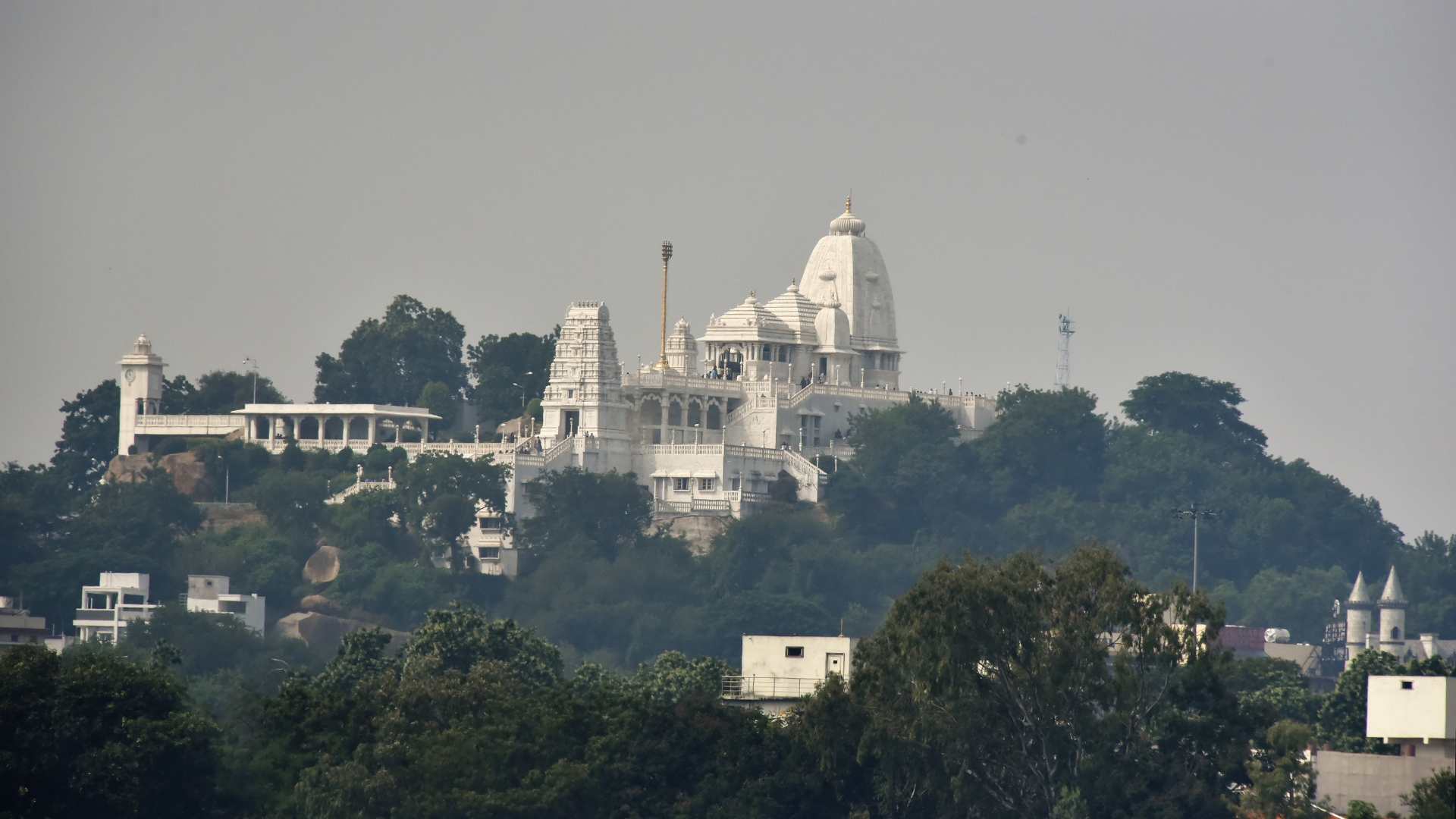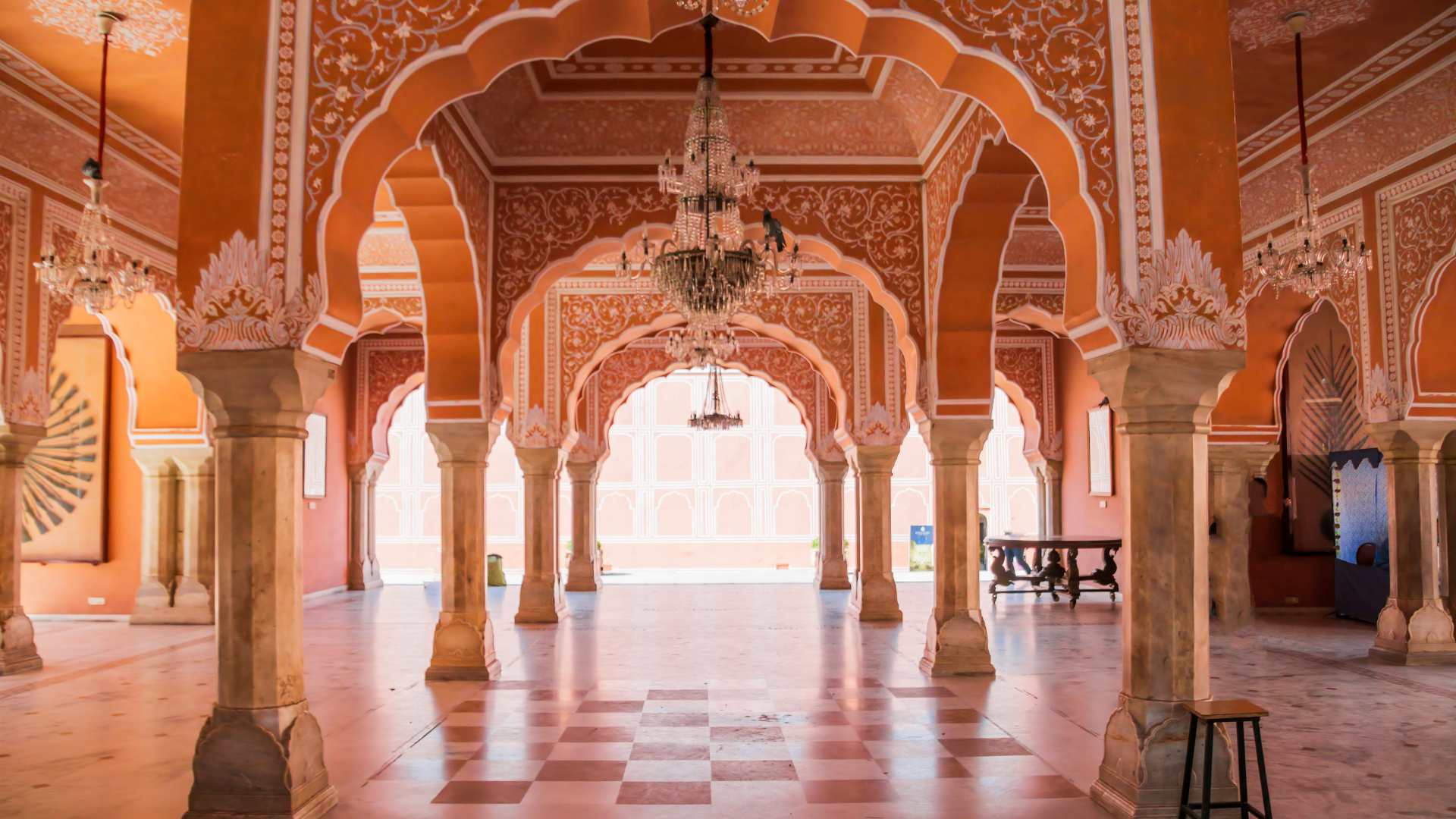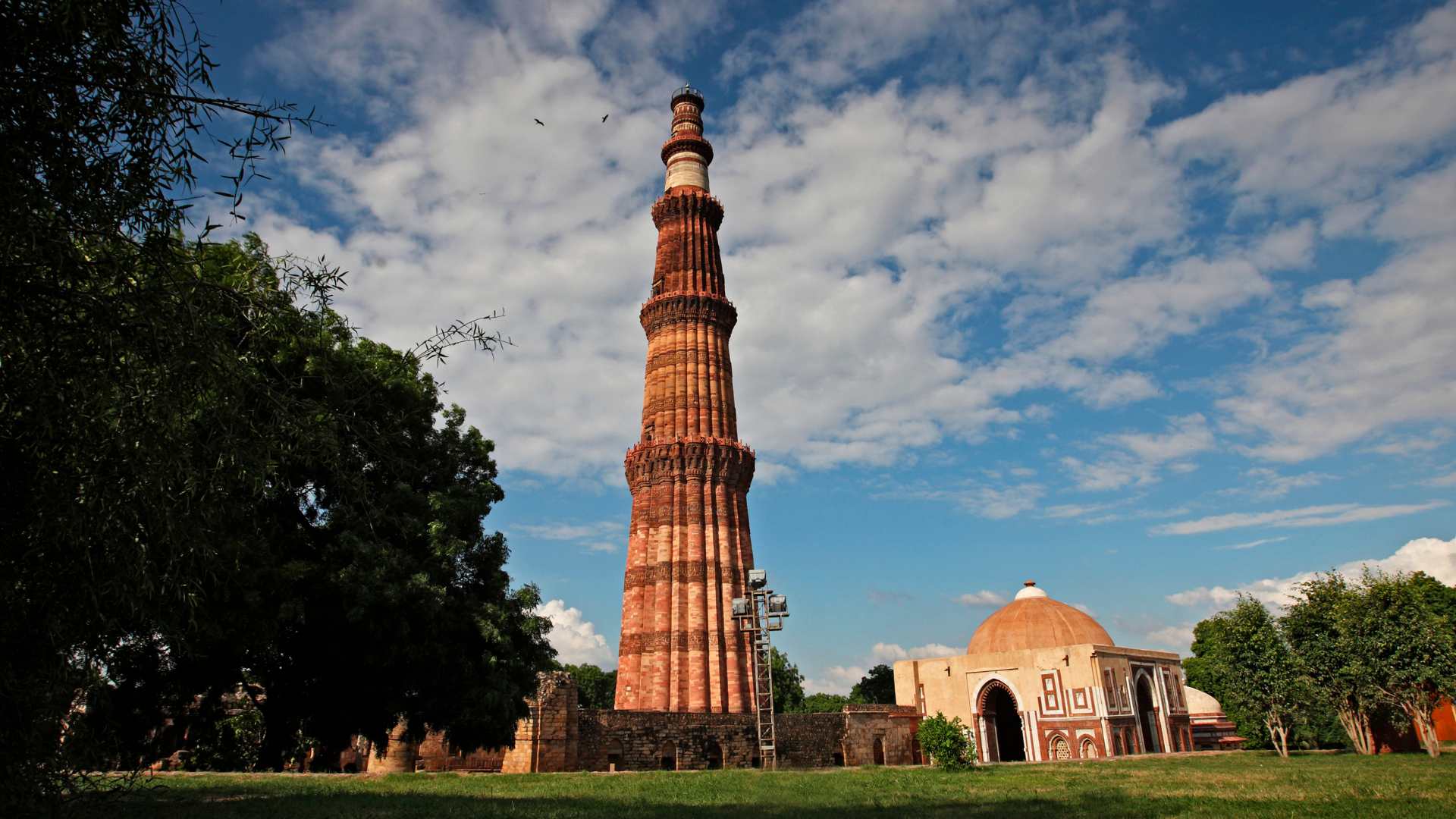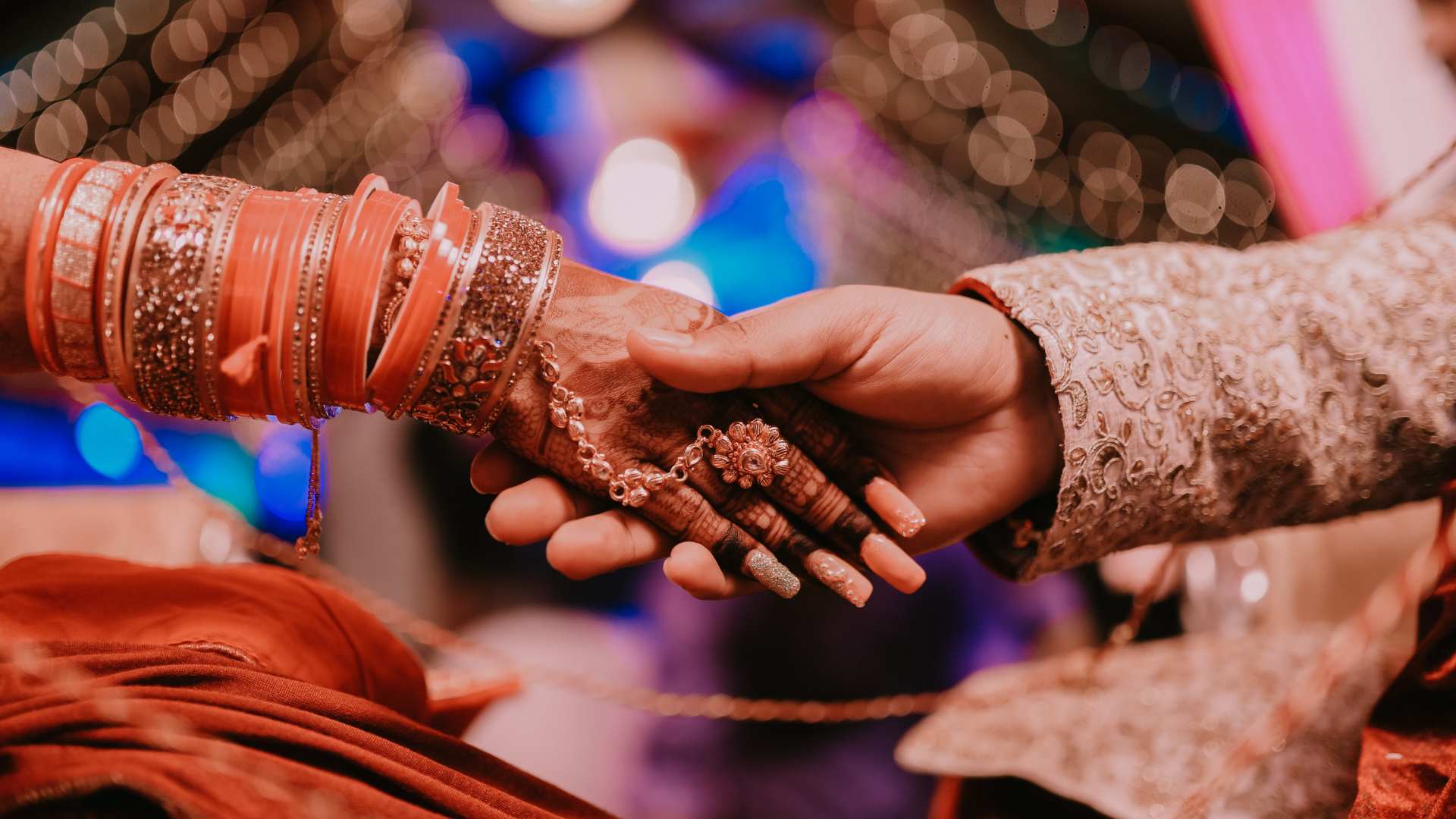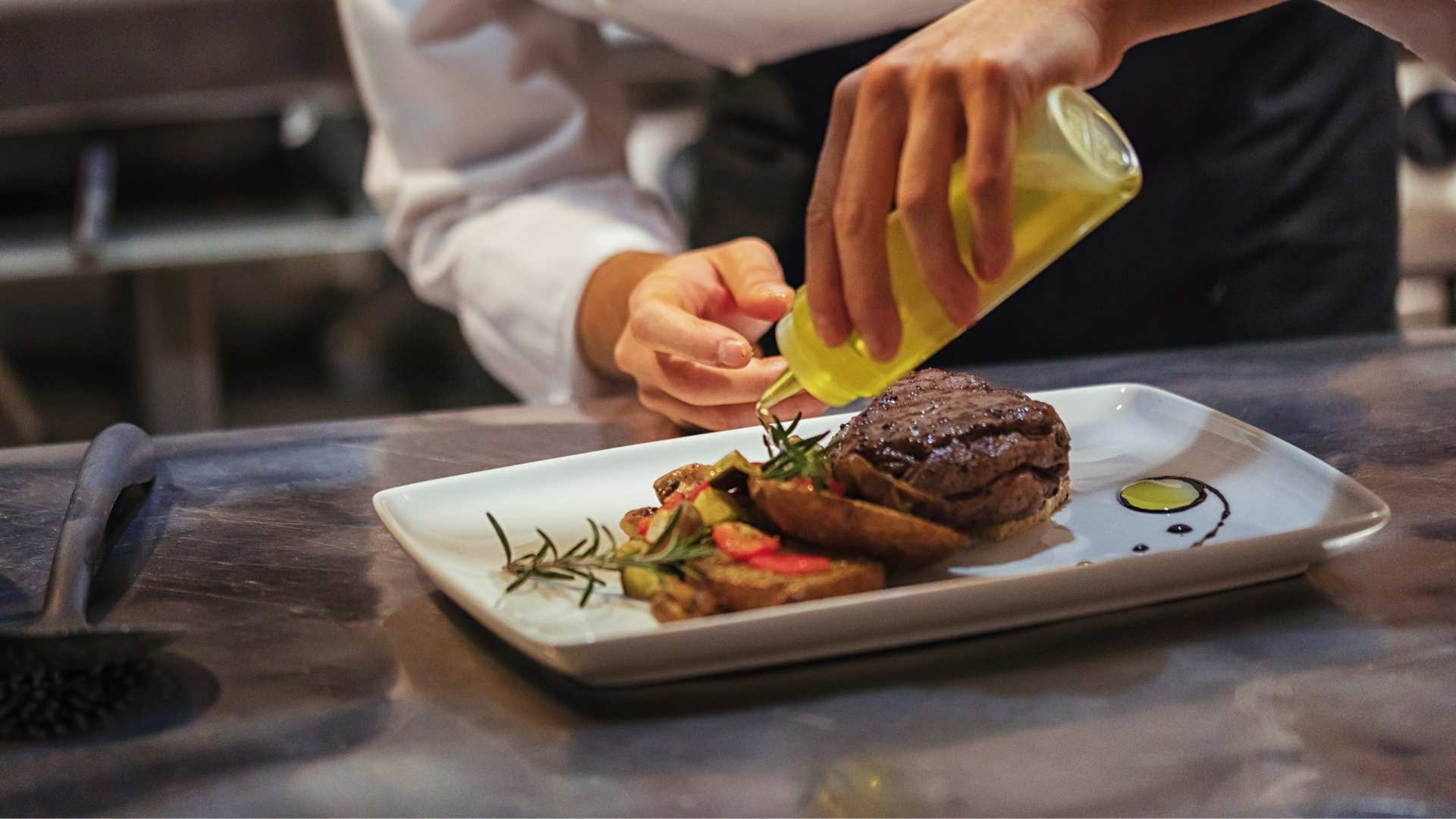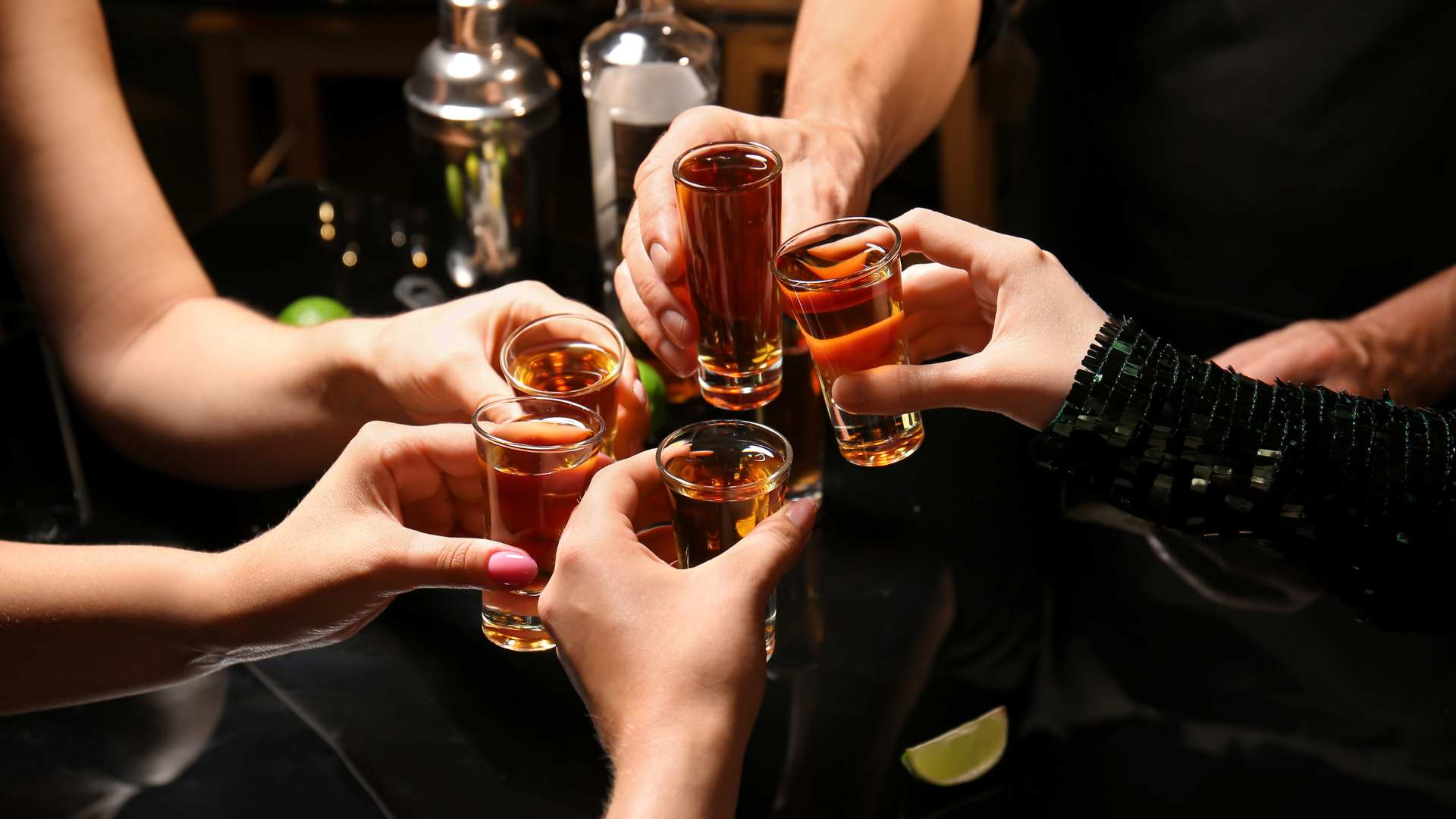Table of Contents
ToggleIndia is a land of unparalleled diversity, and each region tells its own story through art, food, language, and, most strikingly, traditional attire.
Have you ever wondered how a simple fabric can hold centuries of history, culture, and craftsmanship within its threads?
Every corner of India boasts a distinct style of clothing woven from ancient customs and local traditions.
From the vibrant Bandhani of Gujarat to the graceful Kanjeevaram of Tamil Nadu, each dress represents more than just fashion. It reflects a unique identity.
These outfits significantly maintain India’s rich heritage, whether worn during festivals, weddings, or cultural celebrations.
Journey with us through the colourful and intricate world of India’s top 10 traditional dresses and discover the artistry behind them.
Why Are Traditional Dresses So Important in Indian Culture?
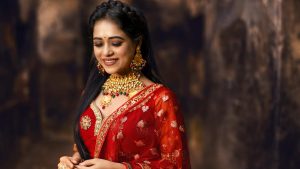
Traditional dresses in India hold immense cultural significance, as they represent the diverse heritage, customs, and values of the country’s many regions.
Clothing is often linked to religious practices, festivals, and ceremonies, with each garment having a unique history and meaning.
For example, the Kanjeevaram saree symbolizes the artistry of Tamil Nadu, while the Bandhani saree represents Gujarat’s vibrant festivals like Navratri.
Wearing traditional attire during significant life events like weddings and religious ceremonies preserves cultural identity and passes traditions to future generations.
These garments are also a reflection of the climate, geography, and local craftsmanship, blending beauty with practicality.
Whether it’s the intricate handwoven patterns or the bold, symbolic colours, traditional Indian clothing carries centuries of history and pride.
What Are the Main Fabrics Used in Traditional Indian Clothing?
India is known for its rich variety of textiles, and traditional garments are often made from fabrics that reflect the local climate and cultural heritage.
Silk is a dominant material, especially for festive and ceremonial outfits like the Kanjeevaram saree from Tamil Nadu and the Mekhela Chador from Assam, both made with high-quality silk.
Cotton, another widely used fabric, is breathable and perfect for hot climates, making it popular for sarees like the Tant saree of West Bengal or the Patiala suit of Punjab.
Fabrics like Muga silk from Assam or Ikat cotton from Odisha highlight the intricate weaving techniques unique to each region.
These fabrics offer comfort and are designed to last, with many garments passed down through generations as heirlooms.
How Has Modern Fashion Influenced Traditional Indian Dresses?
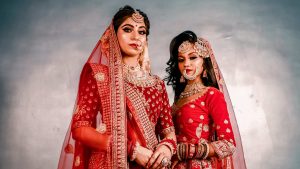
While traditional Indian attire has deep-rooted cultural significance, modern fashion has adapted these garments for contemporary wear.
Designers have introduced lighter fabrics and simpler draping styles to make traditional dresses like sarees more accessible for daily use.
For example, modern Kanjeevaram sarees come in lightweight versions with minimalist designs for ease of movement.
Similarly, men’s traditional outfits like the dhoti or veshti have seen modern adaptations, often paired with western-style shirts for a fusion look.
Festivals like Navratri or Durga Puja still see people wearing traditional outfits but with contemporary twists, like pairing a Bandhani dupatta with jeans or opting for fusion kurtas.
This evolution has made traditional attire more versatile, allowing it to remain relevant while respecting its cultural roots.
What Role Does Handloom Weaving Play in Indian Traditional Clothing?
Handloom weaving is a cornerstone of traditional Indian textiles, representing both cultural heritage and the skilled craftsmanship passed down through generations.
Many of India’s most iconic traditional dresses, such as the Kanjeevaram saree from Tamil Nadu, the Sambalpuri saree from Odisha, and the Mekhela Chador from Assam, are handwoven by artisans.
These craftspeople often work in family-run businesses, using techniques that are hundreds of years old.
The weaving process, particularly intricate in designs like Ikat or Banarasi silk, involves manual labour and attention to detail that machines cannot replicate.
This makes each piece of handwoven fabric unique and valuable. Handloom products are also environmentally sustainable, using natural dyes and fibres, making them an ethical choice for consumers who appreciate both style and craftsmanship.
How Does Climate Influence Traditional Indian Clothing?
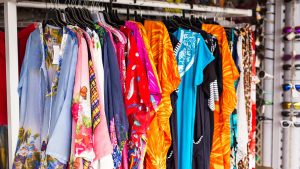
India’s diverse climate has significantly shaped its traditional attire, with fabrics and styles designed to provide comfort while maintaining cultural aesthetics.
In warmer regions like Kerala and Tamil Nadu, lightweight fabrics like cotton and silk are used to make Kasavu sarees and Veshtis, offering breathability and ease in humid weather.
In contrast, regions with cooler climates, like parts of North India, often favor heavier materials such as wool or silk for garments like the Pashmina shawl or the richly embroidered Bandhani saree from Gujarat.
Even the draping styles have evolved with the climate sarees, which are often loosely draped in the south to promote airflow, while in the north, outfits like the Nauvari saree are worn tightly to provide warmth.
This combination of practicality and tradition allows Indian attire to be both functional and beautiful.
How Are Traditional Indian Garments Worn During Festivals and Ceremonies?
Traditional Indian garments are an integral part of festivals and ceremonies, often symbolizing prosperity, purity, or the festive spirit of the occasion.
For example, during weddings, brides typically wear heavy silk sarees like the Kanjeevaram or Banarasi, adorned with gold jewellery, while grooms wear dhotis or kurtas with turbans.
Festivals like Diwali, Navratri, and Durga Puja see both men and women dressed in their finest traditional attire, women donning vibrant sarees or lehengas, and men wearing kurta-pajamas or sherwanis.
These outfits are often passed down as family heirlooms, making them not only garments but cherished possessions.
The colours and designs chosen for these garments are often symbolic red for weddings to signify love, white for mourning rituals, and bright colours for joyful celebrations like Holi and Baisakhi.
Top 10 Traditional Dresses of India
1. Tamil Nadu: Kanjeevaram Saree & Veshti
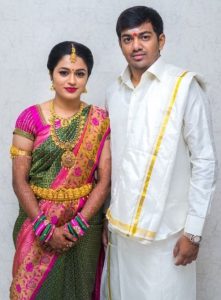
Image – Source
The Kanjeevaram saree, woven in the Kanchipuram town, symbolises Tamil Nadu’s rich cultural heritage. It is one of the most popular sarees in India, celebrated for its bold colours, intricate zari work, and heavy silk fabric.
The Kanjeevaram saree is revered for its grandeur and elegance. It is handwoven and incorporates motifs inspired by temples, flowers, and mythology. It is worn during weddings, festivals, and formal events.
For men, the Veshti is the traditional attire, a simple yet dignified garment made of cotton or silk. It’s usually white or cream with vibrant borders, worn during religious ceremonies, weddings, and cultural festivals.
The Veshti is draped around the waist and paired with an angavastram (shawl) or a shirt, symbolizing Tamil tradition and pride.
Tamil Nadu Traditional Dress Details
| Feature | Description |
| Dress Names | Kanjeevaram Saree (Female) and Veshti (Male) |
| Cultural Significance | Iconic symbols of Tamil Nadu, worn during weddings and festivals, represent Tamil heritage. |
| Fabric & Textiles | Kanjeevaram is made from high-quality silk with zari, while Veshti is crafted from cotton or silk. |
| Design Features | Kanjeevaram features bold colours and intricate temple-inspired motifs. Veshti is a plain cloth with contrasting borders. |
| Colour Palette | Vibrant hues like red, green, and gold for Kanjeevaram. Veshti traditionally comes in white or cream with borders. |
| Wearing Style | Kanjeevaram is draped around the waist with pleats, while Veshti is wrapped and knotted at the waist. |
| Occasions for Use | Worn during weddings, Pongal, Diwali, and religious rituals. |
| Accessories | Paired with gold jewellery for women and simple chains for men. |
| Craftsmanship | Handwoven by skilled artisans in Kanchipuram. |
| Cultural Importance | Reflects Tamil Nadu’s rich textile heritage. |
| Modern Variations | Lighter versions of Kanjeevaram with modern motifs. Veshti styles with contemporary shirt pairings. |
| Seasonal Adaptation | Silk is for winter, and lighter cotton versions are for summer. |
2. Kerala: Kasavu Saree & Mundu
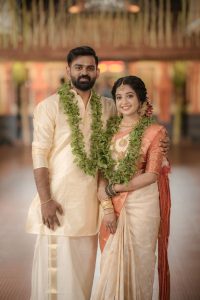
Image – Source
Kerala’s Kasavu saree is instantly recognizable by its elegant simplicity. It features a white or cream base with a striking gold border.
Traditionally worn during festivals such as Onam and Vishu, the Kasavu saree has deep cultural roots in Kerala and symbolizes purity and prosperity.
The fabric is typically woven from cotton or silk, making it suitable for Kerala’s tropical climate. The gold border adds a touch of grandeur.
The Mundu is a versatile garment for men, often worn on formal and casual occasions. It’s a long cloth draped around the waist, commonly paired with a shirt or kurta.
Like the Kasavu saree, the Mundu is also predominantly white or cream, often highlighted with a coloured border, reflecting Kerala’s minimalist yet elegant dressing style.
Kerala Traditional Dress Details
| Feature | Description |
| Dress Names | Kasavu Saree (Female) and Mundu (Male) |
| Cultural Significance | Traditional attire of Kerala, especially during Onam, Vishu, and weddings. |
| Fabric & Textiles | Made from soft cotton or silk, the sarees and Mundu have a gold zari border, while the Mundu is pure cotton. |
| Design Features | Kasavu saree features a plain body with a golden border, while Mundu is a simple white cloth with a border. |
| Colour Palette | White or cream with gold or coloured borders. |
| Wearing Style | Kasavu is draped around the waist with pleats, and Mundu is wrapped around the waist and paired with a shirt. |
| Occasions for Use | Onam, Vishu, religious festivals, and weddings. |
| Accessories | Gold jewellery for women; men typically wear chains or traditional Kerala caps. |
| Craftsmanship | Handwoven by local artisans, particularly from Kerala’s weaving communities. |
| Cultural Importance | Represents purity, prosperity, and Kerala’s minimalist fashion. |
| Modern Variations | Contemporary designs include silver borders and modern motifs. Mundu has modern iterations with coloured borders. |
| Seasonal Adaptation | Cotton variants are favoured for Kerala’s tropical weather. |
3. Karnataka: Ilkal Saree & Panche
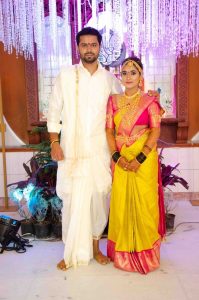
Image – Source
Karnataka’s Ilkal saree is known for its distinct border, pallu, and body combinations, reflecting the artistry of the Ilkal weaving style.
Made from cotton or silk, the saree often features checks or stripes and is widely worn during traditional ceremonies, festivals, and cultural events.
Its durability and unique pattern are recognised, making it both practical and beautiful.
Men in Karnataka traditionally wear the Panche, a long piece of cloth draped around the waist, similar to a dhoti.
The Panche is particularly popular in rural areas and is often paired with a shirt or angavastram (shawl).
The simplicity and ease of wearing the Panche make it a staple attire for men during festivals, weddings, and religious rituals.
Karnataka Traditional Dress Details
| Feature | Description |
| Dress Names | Ilkal Saree (Female) and Panche (Male) |
| Cultural Significance | Worn during festivals, cultural events, and weddings, symbolizing Karnataka’s weaving heritage. |
| Fabric & Textiles | Ilkal sarees are made from cotton, silk, or a blend of both, while Panche is made from pure cotton. |
| Design Features | Ilkal sarees feature checks, stripes, and intricate borders, while Panche is a plain cloth with a coloured border. |
| Colour Palette | Ilkal sarees come in bright red, blue, and green with contrasting borders. Panche is usually white with borders. |
| Wearing Style | Ilkal is draped with the pallu over the shoulder, and Panche is wrapped and knotted around the waist. |
| Occasions for Use | Festivals, weddings, and cultural functions. |
| Accessories | Paired with traditional jewellery for women, men often wear a shawl and sandals. |
| Craftsmanship | Handwoven by artisans in the Ilkal region of Karnataka. |
| Cultural Importance | Reflects Karnataka’s strong weaving traditions and heritage. |
| Modern Variations | Modern Ilkal sarees come in softer fabrics with contemporary designs. |
| Seasonal Adaptation | Cotton sarees and panches are ideal for Karnataka’s tropical climate. |
5. Rajasthan: Ghagra Choli & Angrakha
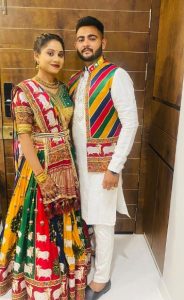
Image – Source
Rajasthan’s Ghagra Choli is an iconic symbol of the state’s vibrant culture. The ghagra, a long skirt, is often heavily embroidered, paired with a short choli (blouse) and an odhni (dupatta).
This attire is known for its bright colours and intricate designs, often featuring mirror work and heavy embellishments.
Rajasthani women wear the Ghagra Choli during festivals like Teej, Gangaur, and weddings, representing the state’s royal heritage and desert lifestyle.
For men, the traditional Angrakha is a long, overlapping tunic tied at the side, usually paired with a dhoti or churidar.
The outfit is completed with the vibrant Rajasthani turban (safa), which varies in style and colour across different regions of Rajasthan.
The Angrakha and turban are often worn during formal events, religious ceremonies, and festivals, embodying Rajasthan’s royal and warrior history.
Rajasthan Traditional Dress Details
| Feature | Description |
| Dress Names | Ghagra Choli (Female) and Angrakha (Male) |
| Cultural Significance | Worn during festivals and weddings, representing Rajasthan’s royal culture and vibrant heritage. |
| Fabric & Textiles | Ghagra Choli is made from cotton, silk, or satin, often embellished with mirror work. Angrakha is made from cotton or silk. |
| Design Features | Ghagra Choli features heavy embroidery, mirror work, and bright colours. Angrakha is an overlapping tunic tied at the side. |
| Colour Palette | Bright colours like red, orange, yellow, and blue are typical. Turbans vary in colour based on the occasion. |
| Wearing Style | Ghagra is a long skirt with a choli and dupatta. Angrakha is worn with a dhoti or churidar, and the turban is styled differently across regions. |
| Occasions for Use | Worn during festivals like Teej, Gangaur, and weddings. |
| Accessories | Women wear silver jewellery, while men accessorize with traditional swords and jewellery. |
| Craftsmanship | Handcrafted by local artisans, with regional variations in embroidery and mirror work. |
| Cultural Importance | Reflects Rajasthan’s royal history and desert culture. |
| Modern Variations | Lighter fabrics and simplified designs for modern wear, with trendy Angrakhas for men. |
| Seasonal Adaptation | Cotton Ghagra Cholis is for summer, and heavier silk versions are for winter festivals. |
5. Maharashtra: Nauvari Saree & Dhoti Kurta
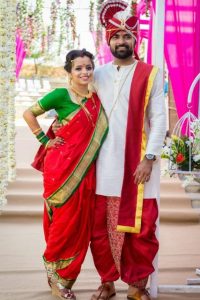
Image – Source
Maharashtra’s Nauvari saree is distinct in its draping style, resembling trousers and allowing for movement.
Women often wear this nine-yard saree during festivals like Ganesh Chaturthi and weddings. The Nauvari’s unique draping is functional and elegant, representing the courage and warrior spirit of Maharashtrian women from history.
Traditionally paired with a blouse and nath (nose ring), the Nauvari saree has become a significant part of the traditional identity of the Maharashtrian.
For men, the Dhoti Kurta is the traditional attire, with the dhoti draped in a way specific to the region.
The outfit is often completed with a pheta (turban), especially during celebrations or religious events.
The Dhoti Kurta is commonly worn during festivals, weddings, and formal occasions, showcasing Maharashtra’s deep-rooted cultural traditions.
Maharashtra Traditional Dress Details
| Feature | Description |
| Dress Names | Nauvari Saree (Female) and Dhoti Kurta (Male) |
| Cultural Significance | It symbolises Maharashtra’s rich cultural history, especially during festivals and weddings. |
| Fabric & Textiles | The Nauvari saree is durable and comfortable, made from silk or cotton. Dhoti Kurtas are typically made from cotton or silk. |
| Design Features | Nauvari is draped in a trouser-like fashion. The dhoti is tied around the waist, and the kurta is simple yet elegant. |
| Colour Palette | Bright colours for Nauvari sarees, with contrasting blouses. Dhotis are typically white or cream with coloured borders. |
| Wearing Style | Nauvari is draped around the waist with the pallu tucked in. The dhoti is wrapped around the waist, and the kurta is worn loose. |
| Occasions for Use | Festivals like Ganesh Chaturthi, weddings, and formal religious occasions. |
| Accessories | Paired with traditional gold jewellery and nath (nose ring) for women, feta (turban) for men. |
| Craftsmanship | Skilled weavers create intricate designs on Nauvari sarees. |
| Cultural Importance | Represents Maharashtra’s warrior heritage and cultural pride. |
| Modern Variations | Contemporary versions of the Nauvari saree have easier draping styles. A dhoti kurta is often worn in modern styles for events. |
| Seasonal Adaptation | Cotton versions are worn during summer, while silk variants are favoured in winter. |
6. Gujarat: Bandhani Saree & Kediyu
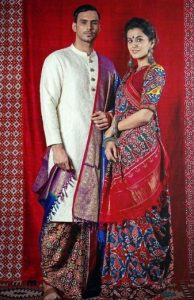
Image – Source
The Bandhani saree from Gujarat is renowned for its unique tie-dye patterns, which were created using a centuries-old traditional method.
The saree’s vibrant colours and intricate designs make it a popular choice during Navratri, weddings, and festivals.
The Bandhani technique involves tying small knots in the fabric before dyeing it, resulting in a distinctive dotted pattern. The saree is lightweight, easy to drape, and a perfect symbol of Gujarat’s lively culture.
For men, the Kediyu is a traditional garment worn during cultural festivals, especially Navratri.
It’s a short, flared kurta often paired with a dhoti or churidar and worn with a turban. The Kediyu’s flowing design allows for ease of movement, especially during Garba, a traditional folk dance performed during Navratri.
Gujarat Traditional Dress Details
| Feature | Description |
| Dress Names | Bandhani Saree (Female) and Kediyu (Male) |
| Cultural Significance | Worn during festivals like Navratri and weddings, representing Gujarat’s vibrant culture. |
| Fabric & Textiles | Bandhani sarees are made from cotton or silk and dyed using the tie-dye technique. Kediyu is made from cotton. |
| Design Features | Bandhani sarees feature intricate tie-dye patterns. Kediyu is a flared kurta with a fitted waist. |
| Colour Palette | Bright colours like red, yellow, green, and blue, typically used in Bandhani sarees. Kediyu is often white or made of solid colours. |
| Wearing Style | Bandhani is draped in a traditional style. Kediyu is worn with a dhoti or churidar. |
| Occasions for Use | Navratri, Garba, and other cultural festivals. |
| Accessories | Paired with heavy silver jewellery for women, men wear traditional turbans and sandals. |
| Craftsmanship | It was created using a centuries-old tie-dye method, handwoven by artisans. |
| Cultural Importance | Represents Gujarat’s unique tie-dye tradition and cultural festivals. |
| Modern Variations | Contemporary Bandhani designs with modern dyeing techniques. Kediyus are paired with modern churidars for casual wear. |
| Seasonal Adaptation | Lighter cotton variants are available for summer, and silk sarees are available for winter festivals. |
7. Punjab: Patiala Suit & Kurta Pajama
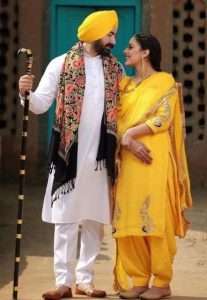
Image – Source
Punjab’s Patiala suit is a popular form of traditional wear for women. It features a loose salwar (pants) with pleats paired with a short, fitted kameez (tunic).
The Patiala suit is known for its comfort and freedom of movement, making it ideal for everyday wear and festivals.
Worn with a dupatta, the Patiala suit is often vibrant and decorated with intricate embroidery or Phulkari (flower embroidery), symbolizing Punjabi culture’s joyful and lively nature.
For men, the Kurta Pajama is the traditional attire worn with a turban (pagri) as part of the Sikh identity.
The kurta is a long, loose-fitting shirt worn over pajama trousers, often worn during religious ceremonies, weddings, and festive events. The outfit symbolizes simplicity, tradition, and the proud culture of Punjab.
Punjab Traditional Dress Details
| Feature | Description |
| Dress Names | Patiala Suit (Female) and Kurta Pajama (Male) |
| Cultural Significance | Worn during festivals like Lohri, Baisakhi, and weddings, representing Punjab’s lively spirit. |
| Fabric & Textiles | Made from cotton, silk, or satin with Phulkari embroidery. Kurta Pajama is usually made from cotton or silk. |
| Design Features | Patiala features pleated salwar pants with a fitted kameez. Kurta Pajama is a loose-fitting long shirt with pajama trousers. |
| Colour Palette | With embroidered details and bright colours like red, green, blue, and orange. |
| Wearing Style | Patiala suit is paired with a dupatta, while Kurta Pajama is worn with a turban for men. |
| Occasions for Use | Worn during religious festivals, weddings, and everyday casual wear. |
| Accessories | Paired with silver or gold jewellery for women, men wear a pagri (turban). |
| Craftsmanship | Phulkari embroidery is a traditional craft of Punjab that skilled artisans created. |
| Cultural Importance | Represents the vibrant and festive spirit of Punjab. |
| Modern Variations | Contemporary Patiala suits with modern cuts and embroidered kurtas for men. |
| Seasonal Adaptation | Lighter cotton versions are ideal for summer, while silk or satin is worn in winter. |
8. Assam: Mekhela Chador & Dhoti-Gamosa
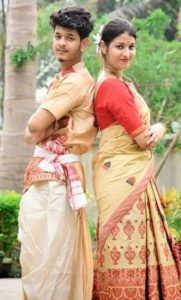
Image – Source
Assam’s traditional attire for women, the Mekhela Chador, is a graceful two-piece garment. The Mekhela, a long cylindrical skirt, is worn with a Chador, a draped cloth around the upper body.
This elegant outfit is made from Muga silk, a fabric exclusive to Assam, known for its natural golden sheen.
The Mekhela Chador is intricately designed with motifs inspired by Assam’s natural surroundings, like flowers, birds, and traditional patterns.
It is typically worn during Bihu, weddings, and other cultural celebrations, symbolizing Assam’s rich heritage and elegance.
The Dhoti paired with a Gamosa (traditional scarf) is the go-to attire for men during festivals, weddings, and religious ceremonies.
The Dhoti is a simple, long cloth wrapped around the waist, while the Gamosa, a handwoven cotton towel, is draped around the shoulders. These garments reflect Assam’s simplicity and deep connection with nature and tradition.
Assam Traditional Dress Details
| Feature | Description |
| Dress Names | Mekhela Chador (Female) and Dhoti-Gamosa (Male) |
| Cultural Significance | Worn during festivals like Bihu and cultural events, symbolizing Assamese tradition and grace. |
| Fabric & Textiles | Mekhela Chador is made from Muga silk or Pat silk. Dhoti and Gamosa are handwoven from cotton. |
| Design Features | Mekhela Chador has intricate motifs inspired by nature, and the Dhoti is a plain white cloth with a Gamosa draped over the shoulder. |
| Colour Palette | Pastel shades, white, gold, and soft hues are used for Mekhela Chador. The dhoti is usually white, and the Gamosa is red and white. |
| Wearing Style | Mekhela is a draped skirt, and the Chador is worn around the upper body. A dhoti is wrapped around the waist, and a Gamosa is draped over the shoulder. |
| Occasions for Use | Bihu festival, weddings, and religious ceremonies. |
| Accessories | Paired with traditional Assamese jewellery like Junbiri and Lokaparo for women, simple jewellery for men. |
| Craftsmanship | Handwoven by Assamese artisans using traditional techniques. |
| Cultural Importance | Represents Assam’s weaving heritage and cultural pride. |
| Modern Variations | There are lighter, modern versions of the Mekhela Chador for everyday wear, and dhoti styles have also adapted to modern fashion. |
| Seasonal Adaptation | Silk is used for winter festivals, and lighter cotton is used for Mekhela Chadors for summer. |
9. Odisha: Sambalpuri Saree & Dhoti Kurta
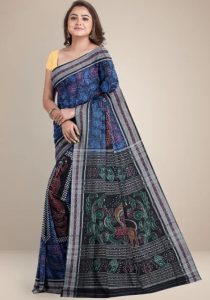
Image – Source
The Sambalpuri saree is a source of pride for Odisha and is known for its unique Ikat weaving technique. Each saree is handwoven, with patterns and motifs dyed into the threads before weaving, creating vibrant and intricate designs.
The sarees are traditionally worn during festivals like Rath Yatra and Durga Puja, symbolizing Odisha’s rich cultural and artistic heritage.
These sarees are made from cotton or silk, and their unique designs often feature motifs like shells, flowers, and geometric patterns, representing the deep cultural roots of the region.
The traditional Dhoti Kurta is the preferred attire for men, particularly during religious ceremonies and festivals.
The Dhoti is a simple garment draped around the waist, while the Kurta is a long shirt. This combination symbolizes Odisha’s deep-rooted traditions and its people’s simple yet elegant lifestyle.
Odisha Traditional Dress Details
| Feature | Description |
| Dress Names | Sambalpuri Saree (Female) and Dhoti Kurta (Male) |
| Cultural Significance | Worn during festivals like Rath Yatra and weddings, representing Odisha’s weaving heritage. |
| Fabric & Textiles | Sambalpuri sarees are handwoven from silk or cotton using the Ikat technique. Dhoti Kurta is usually made from cotton or silk. |
| Design Features | Sambalpuri sarees feature intricate Ikat designs and traditional motifs. The Dhoti is plain, paired with a simple kurta. |
| Colour Palette | Bright colours like red, green, and blue for Sambalpuri sarees with intricate patterns. Dhoti is traditionally white or cream. |
| Wearing Style | Sambalpuri sarees have pleats at the front. A dhoti is wrapped around the waist, and the kurta is worn loose. |
| Occasions for Use | Rath Yatra, Durga Puja, and other religious or cultural festivals. |
| Accessories | Paired with silver or gold jewellery for women, men wear simple chains or amulets. |
| Craftsmanship | Handwoven by skilled artisans using the intricate Ikat technique, which involves resist dyeing. |
| Cultural Importance | Reflects Odisha’s artistic heritage and intricate craftsmanship. |
| Modern Variations | Contemporary Sambalpuri sarees with lighter fabrics and modern designs. Dhoti Kurtas are now styled with more modern fabrics for casual wear. |
| Seasonal Adaptation | Cotton Sambalpuri sarees for summer, while silk versions are worn during the cooler months. |
10. West Bengal: Tant Saree & Panjabi Dhoti
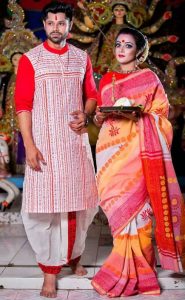
Image – Source
West Bengal’s Tant saree is lightweight and perfect for the humid climate, making it a popular choice for daily wear and festivals like Durga Puja.
These sarees are known for their crisp cotton fabric and intricate threadwork, often featuring floral and paisley motifs.
Tant sarees are handwoven by artisans and are widely worn by Bengali women to symbolise simplicity and elegance.
The light, breathable fabric makes it ideal for everyday use, but its intricate designs and vibrant colours also make it suitable for formal occasions.
For men, the panjabi (Bengali version of the kurta) paired with a Dhoti is the traditional attire. This combination is typically worn during Durga Puja, weddings, and religious events, symbolizing Bengal’s rich cultural heritage.
The panjabi is a long, loose shirt often made from cotton or silk, making it comfortable and suitable for Bengal’s tropical weather.
West Bengal Traditional Dress Details
| Feature | Description |
| Dress Names | Tant Saree (Female) and Panjabi Dhoti (Male) |
| Cultural Significance | Worn during Durga Puja, weddings, and other cultural events, representing Bengal’s textile heritage. |
| Fabric & Textiles | Tant sarees are made from lightweight cotton, while the Panjabi Dhoti is typically crafted from cotton or silk. |
| Design Features | Tant sarees feature floral and paisley motifs with intricate threadwork. Panjabi is a long shirt paired with a plain or bordered dhoti. |
| Color Palette | Tant sarees are available in white, red, blue, and pastel shades. Dhotis are usually white or cream, while panjabis can come in various colours. |
| Wearing Style | Tant sarees are draped with the pallu over the shoulder. Panjabi is worn loose over a dhoti tied at the waist. |
| Occasions for Use | Durga Puja, weddings, and religious festivals. |
| Accessories | Paired with traditional Bengali gold jewellery for women, men often wear simple jewellery or traditional sandals. |
| Craftsmanship | Handwoven by artisans using traditional loom techniques passed down through generations. |
| Cultural Importance | Reflects Bengal’s textile tradition and its cultural identity. |
| Modern Variations | Lightweight Tant sarees with modern patterns and Panjabis with fusion designs for casual occasions. |
| Seasonal Adaptation | Cotton Tant sarees are worn during the summer, while silk dhotis are used during cooler months. |
Conclusion
The traditional dresses of India are much more than beautiful garments; they are symbols of the country’s diverse cultural tapestry.
Each dress encapsulates a region’s history, climate, and traditions, from the delicate weaves of Assam’s Mekhela Chador to the bold patterns of Rajasthan’s Ghagra Choli.
These outfits connect people to their past and continue to thrive in modern fashion, proving their timelessness.
Whether a saree is elegant or a veshti simple, traditional Indian attire remains a powerful expression of identity and heritage.
As the world becomes more interconnected, these garments remind us of the importance of preserving and celebrating our cultural roots. With its richness and variety, India’s traditional clothing continues to inspire awe and admiration worldwide.
FAQs About Top 10 Traditional Dresses of India
What is the most famous traditional dress in India?
The saree is perhaps India’s most famous traditional dress, with regional variations like the Kanjeevaram, Bandhani, and Nauvari sarees being particularly well-known.
How are traditional Indian dresses different in each region?
Traditional Indian dresses vary based on the region’s climate, cultural practices, and historical influences. For example, Tamil Nadu’s Kanjeevaram sarees use heavy silk, while Kerala’s Kasavu sarees are simpler with golden borders.
What materials are typically used for making traditional Indian dresses?
Fabrics like silk, cotton, wool, and linen are commonly used for traditional Indian dresses. Certain regions, like Assam, are known for Muga silk, while Gujarat is famous for Bandhani tie-dye work.
Can men’s traditional clothing in India be worn casually?
Yes, traditional men’s clothing like the kurta-pajama, dhoti, and veshti are often worn casually, especially in rural areas or during festivals.
Why do different regions in India have unique traditional attire?
India’s geography, culture, and history diversity have led to distinct traditional attire in different regions. Clothing styles often reflect local customs, religious beliefs, and the area’s climate.
How has Indian traditional clothing influenced global fashion?
Indian textiles like silk, cotton, and intricate embroidery have greatly influenced global fashion, with designers incorporating elements like saree draping, embroidery, and traditional prints into modern fashion.
Are traditional Indian dresses still worn in everyday life?
Yes, many Indians still wear traditional attire, especially during festivals, weddings, and religious ceremonies, though wearing western-style clothing in daily life is more common.



